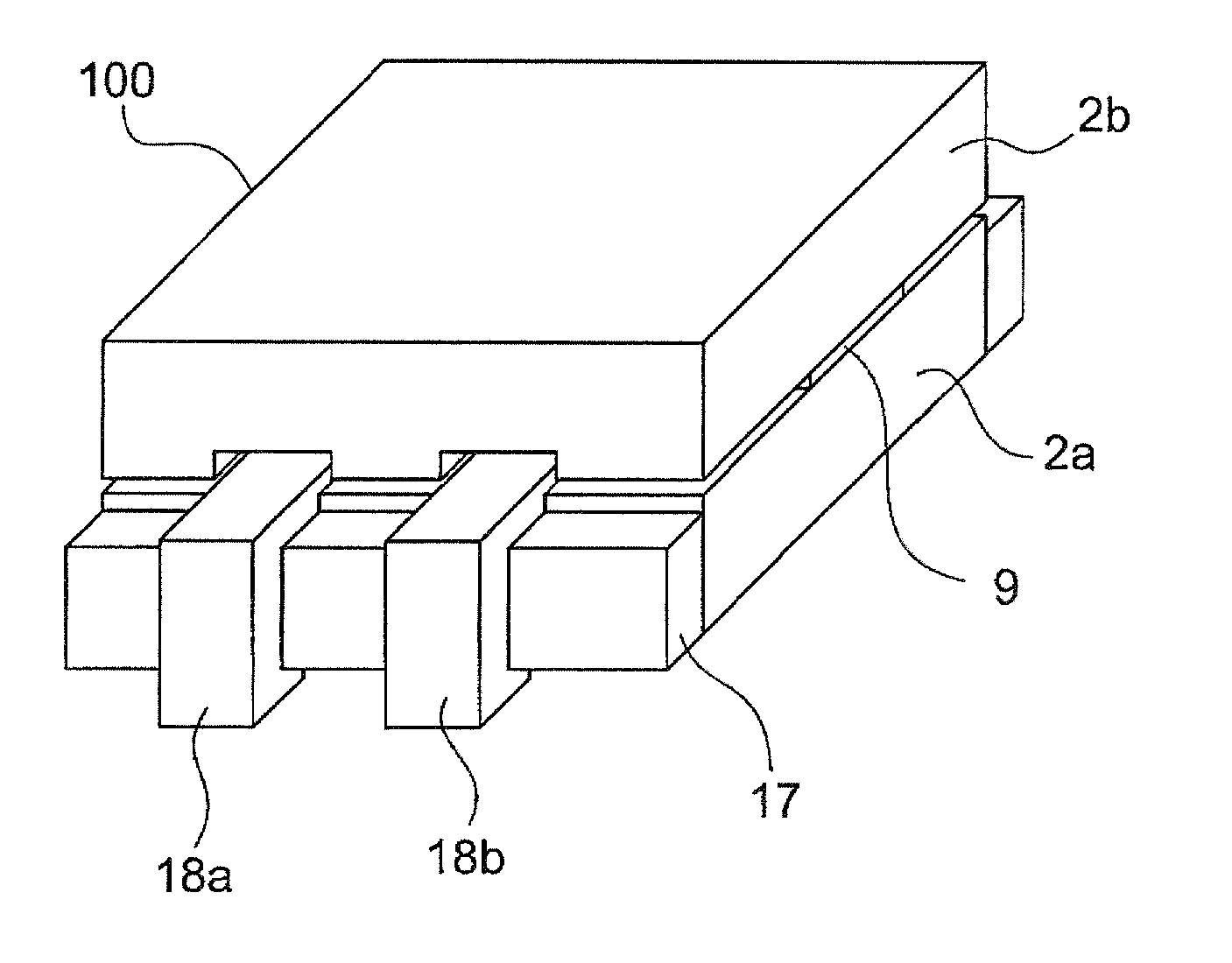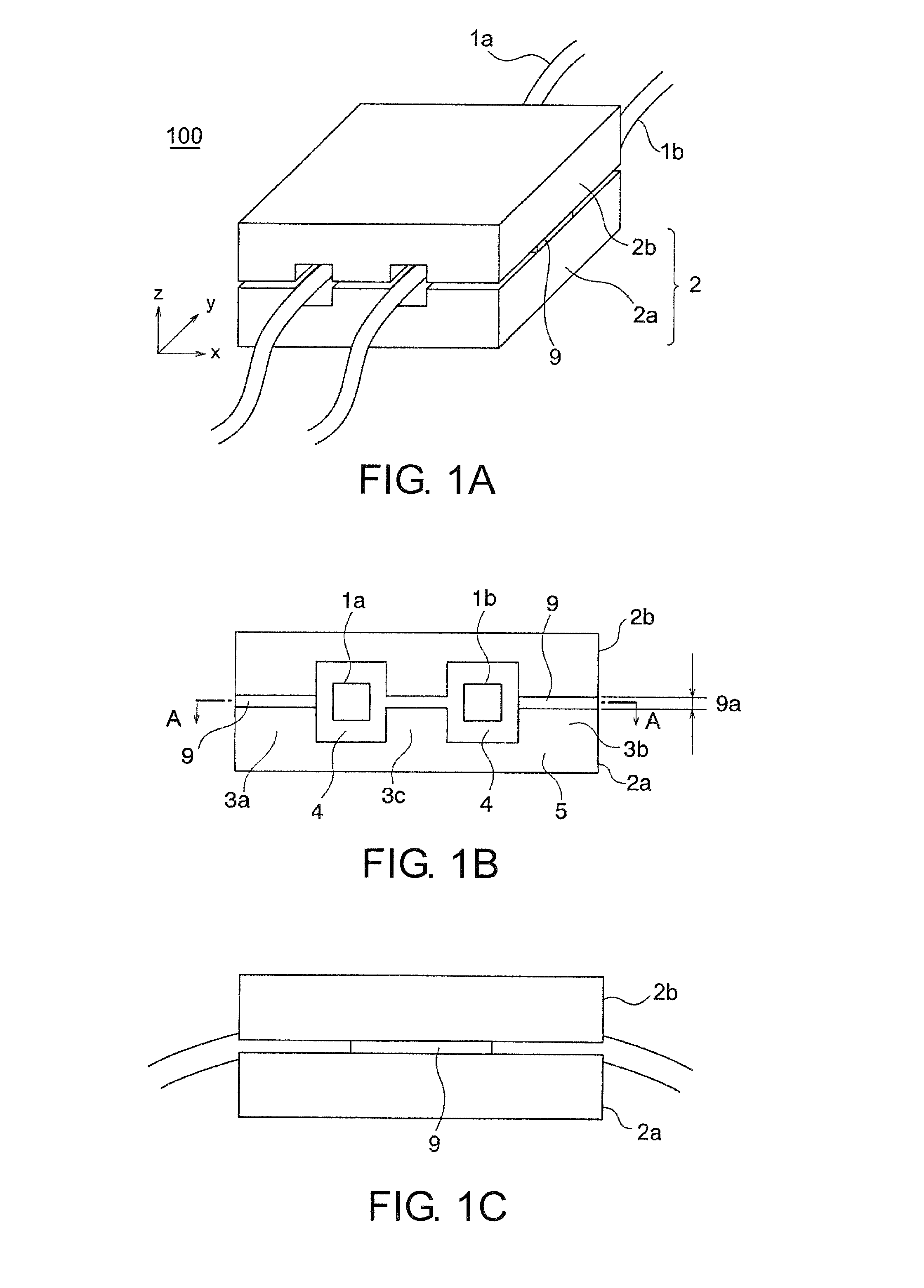Inductor
a technology of inductance and transformer, applied in the field of inductance, can solve the problems of power source efficiency reduction and inductance drop
- Summary
- Abstract
- Description
- Claims
- Application Information
AI Technical Summary
Benefits of technology
Problems solved by technology
Method used
Image
Examples
example 1
[0082]Using an NiZn ferrite which had a permeability of 600 and a saturation flux density of 450 mT, a second magnetic substance core 2a of E-type as shown in FIG. 2 was prepared so as to have a width of 8 mm, a length of 12 mm and a height of 3.6 mm. A first magnetic substance core 2b to pair with the second magnetic substance core 2a was also prepared in the same shape as that of the second magnetic substance core 2a. The outer legs 3a and 3b and the middle legs 3c and 3d of these cores 2a and 2b were butted against each other through gap materials 9, into a magnetic substance core assembly 2, whereby an inductor 100 shown in FIG. 1 was fabricated. Besides, each of the middle legs 3c and 3d of the magnetic substance cores was configured having a width of 1.0 mm and a length of 1.0 mm. Further, each of the middle-leg non-formation parts of the magnetic substance cores was so configured that its length l was 10 mm, and each of voids 4 serving as the inlets / outlets of conductors was ...
example 2
[0086]In this example, an inductor was fabricated under the same conditions as in Example 1, except that only the length l of the middle-leg non-formation part in Example 1 was altered. Table 2 indicates the list of the electrical performances of the inductor in Example 2.
TABLE 2Middle-legnon-formationCouplingSelf-InductanceLeakage Inductancepart (mm)Coefficient KLs (μH)(μH)00.550.640.2920.600.630.2540.650.610.2280.760.570.14120.920.520.04
[0087]From the result of Table 2, it has been confirmed that the coupling coefficient K and the leakage inductance are respectively adjustable in a range of from 0.55 to 0.92 and in a range of from 0.29 to 0.04 by changing the length of the middle-leg non-formation part.
example 3
[0088]In this example, an inductor was fabricated under the same conditions as in Example 2, except that an MnZn ferrite having a permeability of 2200 and a saturation flux density of 510 mT was employed. Table 3 indicates the list of the electrical performances of the inductor in Example 3.
TABLE 3Middle-legnon-formationCouplingSelf-InductanceLeakage Inductancepart (mm)Coefficient KLs (μH)(μH)00.560.870.3920.610.800.3540.660.830.2980.780.780.10120.940.710.05
[0089]Table 3 indicates the coupling coefficient K and the inductances depending on changes in the length l of the middle-leg non-formation part in the case of employing the MnZn ferrite core assembly. It is seen from the result of Table 3 that the coupling coefficient K exhibits almost the same values as in the case of employing the NiZn ferrite in Table 2, but that the self-inductance Ls has attained larger values in correspondence with the higher permeability of the material Thus, it has been confirmed that, even in the case o...
PUM
| Property | Measurement | Unit |
|---|---|---|
| saturation flux density | aaaaa | aaaaa |
| current | aaaaa | aaaaa |
| current | aaaaa | aaaaa |
Abstract
Description
Claims
Application Information
 Login to View More
Login to View More - R&D
- Intellectual Property
- Life Sciences
- Materials
- Tech Scout
- Unparalleled Data Quality
- Higher Quality Content
- 60% Fewer Hallucinations
Browse by: Latest US Patents, China's latest patents, Technical Efficacy Thesaurus, Application Domain, Technology Topic, Popular Technical Reports.
© 2025 PatSnap. All rights reserved.Legal|Privacy policy|Modern Slavery Act Transparency Statement|Sitemap|About US| Contact US: help@patsnap.com



